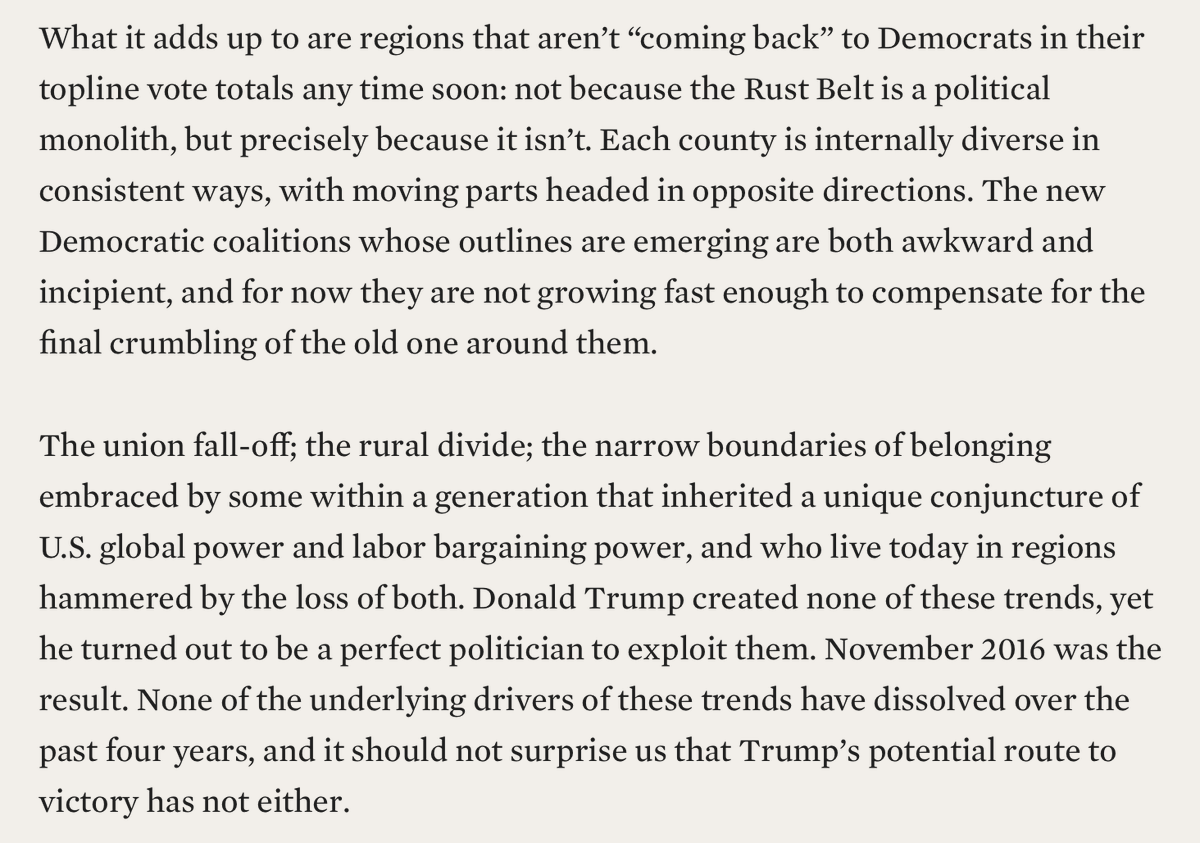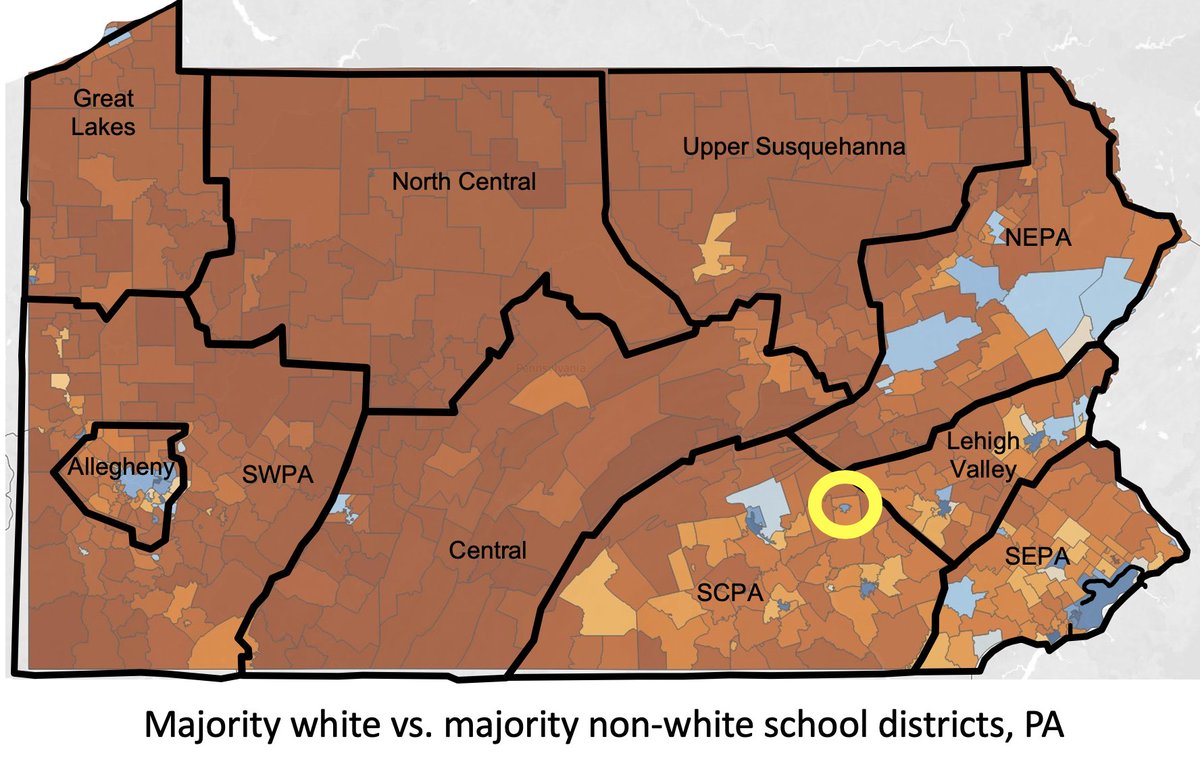Three carefully reported articles from non-metro PA that should be read together. They offer radically different takeaways, but by listening carefully to diff voices capture the same reality: very real currents moving in opposite directions, w/gender & esp generation key divides
First, from @JuliaTerruso a really thoughtful account of aging white men continuing to move away from the Democratic party in Carbondale, as union jobs & allegiance forged 2 generations ago fade, & messages about "far left" extremes resonate... with some https://www.inquirer.com/politics/pennsylvania/carbondale-pennsylvania-trump-biden-2020-election-20200808.html
But note the civic stalwart aging moms rejecting the Trump msg... & the 20something daughter sad about political division but outspoken on racial injustice: “My heart hurts for the minorities in this town because I don’t feel like they’re treated properly."
Read it alongside @TimAlberta's dispatch fr Scranton: which among other things does a great job of reflecting in its interviewees, just how much of the Rust Belt "working class" (white & otherwise) is made up of health care workers today... https://www.politico.com/news/magazine/2020/07/28/letter-to-washington-scranton-white-working-class-381320
Among the brilliantly observed subtle details here: 16 yr old Jerry, quietly on his smartphone on the porch of a Scranton duplex, is clearly inhabiting a different world of political information than the 50-80 yr olds around him https://www.politico.com/news/magazine/2020/07/28/letter-to-washington-scranton-white-working-class-381320
That 2 thoughtful reporters reach opposite conclusions just means each is doing their job well & "Lackawanna County" isn't the right unit of analysis. Scranton is the dot getting bluer in @JMilesColeman's map below; Carbondale is in the green circle to its right, getting redder
Here's a long thread fr me in the wake of last November's (county/municipal) elections, explaining why focusing on countywide totals can lead you to misunderstand the currents underway: some of them decades long & ongoing; others new but critical to future https://twitter.com/lara_putnam/status/1192631328186994688
And here's an article in which I got to spend 6000 words (thank you @mtomasky) explaining why that fractal quality of America's political geography really matters for the social-organizational processes slowly remaking ex-industrial regions' politics today https://democracyjournal.org/magazine/57/rust-belt-in-transition/
I feel like this—written 6 months eg a lifetime ago, in a different universe—has held up pretty well regardless https://democracyjournal.org/magazine/57/rust-belt-in-transition/
Recognizing the spatially-concentrated internal diversity of Rust Belt/rural regions that look "largely white" at a distance is critical to understanding the range of places where #BlackLivesMatter  protests have been held since May: & why they matter https://twitter.com/lara_putnam/status/1273094191200026624
protests have been held since May: & why they matter https://twitter.com/lara_putnam/status/1273094191200026624
 protests have been held since May: & why they matter https://twitter.com/lara_putnam/status/1273094191200026624
protests have been held since May: & why they matter https://twitter.com/lara_putnam/status/1273094191200026624
Which leads to the 3rd article that should be read alongside the two focused on the presidential contest/ Lackawanna: this, from Lebanon PA, which captures all kinds of dynamics critical to shaping electoral trends over time, yet are rarely covered as such https://whyy.org/articles/voices-of-the-movement-meet-the-women-who-organized-the-anti-racist-protest-in-this-divided-pa-town/
That's Lebanon PA in the yellow circle: a 2/3 Hispanic school district, today, in a county that's ~92% non-Hispanic white.
Read about Michelle Cotton—who grew up Black in racially divided Lebanon PA & could not previously find allies to join her in collective action speaking out—& about how this time was different. Because, young people. https://whyy.org/articles/voices-of-the-movement-meet-the-women-who-organized-the-anti-racist-protest-in-this-divided-pa-town/
This story—of young, Black, new-to-organizing leaders stepping forward alongside high school friends whose own experience with race has been different, but who are now trying to be active allies—has played out in place after place, including some very white, very PA small towns
... generating this map: Over 400 separate protests in support of #BlackLivesMatter  & against police brutality & structural racism, held in over 230 separate PA communities, over the course of just 5 wks this spring
& against police brutality & structural racism, held in over 230 separate PA communities, over the course of just 5 wks this spring
 & against police brutality & structural racism, held in over 230 separate PA communities, over the course of just 5 wks this spring
& against police brutality & structural racism, held in over 230 separate PA communities, over the course of just 5 wks this spring

 Read on Twitter
Read on Twitter









